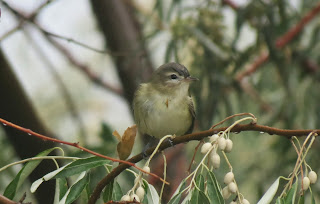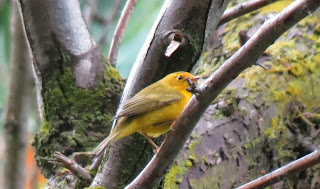May 22nd - Day 1
Sweetwater Wetlands
We arrived in Tuscon on May 22nd after an hour and half long flight. Tired from travel we went to bed early, ready for the following day.
 |
| Tuscon from the plane |
The next morning we got up early and drove to the well known Sweetwater Wetlands. Due to construction, it took quite a bit more time than expected to get there. After a few U-turns and detours we finally made it to Sweetwater.
 | |||
| Sweetwater Wetlands |
 | |||
| Verdin. A tiny desert bird with a bright yellow head. |
We walked around the trails picking up Abert's Towhee, Wilson's Warbler,
Western Wood-Pewee, and my lifer
Curve-billed Thrasher. The Curve-billed Thrasher was my first of many
lifers on the trip.
 | ||
| Distant picture of my lifer Curve-billed Thrasher |
 | |
| Killdeer in flight |
 |
| Feeding ducks in the recharge basin |
Also in the area were lots of swallows and swifts, flying over the water. We saw many Northern Rough-winged and Cliffs, as well as a few Barn swallows.
 |
| White-throated Swift |
 |
| Life bird #2. Tropical Kingbird |
Complete Ebird check list here: http://ebird.org/ebird/view/checklist?subID=S14296623
Roger Road WRF
We drove down the road from Sweetwater, arriving at the Roger Road facility. We checked in with the guard and he let us in to bird. Inside the gates we were welcomed by a cooing Inca Dove on an over hanging power line.
 |
| Poor shot of an Inca Dove |
 | ||
| Doves at Roger Road WRF |
 |
| Cassin's Kingbird. |
Right after viewing the goldfinches we both heard an unfamiliar bird. It was a loud, almost laughing like sound. We followed the call until we found the culprit. High on a palm tree we found a pair of Gila Woodpeckers. These flicker like birds were my third life bird. It was fun to watch them fly back and forth between trees, calling back and forth. These would turn out to be quite common throughout the rest of the trip.
 |
| Gila Woodpecker |
Complete Ebird check list for Roger Road: http://ebird.org/ebird/view/checklist?subID=S14296679
Along the way we picked up new trip birds like Ash-throated Flycatcher, Cactus Wren, and a beautiful adult Harris' Hawk.
We took a stop in between Tuscon and Portal at the Cienega Creek Preserve. This place was hopping with birds. This was a very cool spot to bird. Right when we got out of the car we could hear singing Black-throated Sparrows from the desert surrounding the wash and the pit-tic calls of both Western and Summer Tanagers coming from the tall Cottonwood Trees.
 |
| Cienega Creek Preserve |
 |
| Cienega Creek |
 |
| Abert's Towhee - Very common around the preserve. |
Bright colored birds were everywhere along the creek. We saw Black-headed Grosbeak, Northern Cardinal, Pyrrhuloxia, Summer and Western Tanager, and Bullock's Oriole, all in good numbers.
Here's a small taste of the colorful birds we saw on the preserve:
 |
| Summer Tanager - These birds stood out very well against the green of the leaves. |
 |
| Northern Cardinal |
 |
| Male Vermilion Flycatcher |
As we were walking back to the car we saw our fifth life bird of the trip. A female Gray Hawk. It flushed out of a large cottonwood above us and flew through the trees and out of sight before I could snap a picture.
Other birds of interest included a male Bronzed Cowbird, Pacific-slope Flycatcher, and a single Purple Martin.
After birding the preserve we drove straight to Portal, Arizona, where we would spend the next two days.
We arrived at Sunny Flat Campground in the Chiricahua Mountains that night at around 8:30 p.m. This would be our camping spot for the next couple of days. We set up camp and went owling. At first there was very little bird activity, but after a while the first Elf Owl called. Soon 4-5 of these little owls could be heard at once! When I finally found one with the flashlight, I was amazed at how tiny they were!
Elf Owl on xeno-canto: http://www.xeno-canto.org/species/Micrathene-whitneyi
I couldn't wait for the next morning. Tomorrow would be my first real day of birding in South East Arizona. I fell asleep listening to the Elf Owls and a "Mexican" Whip-poor-Will trilling.
































































